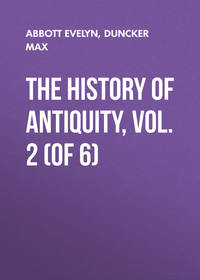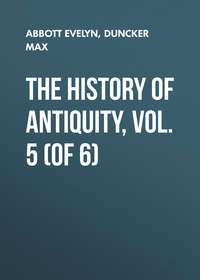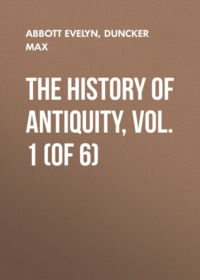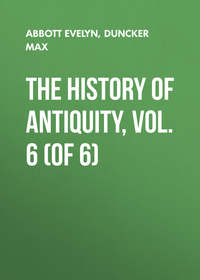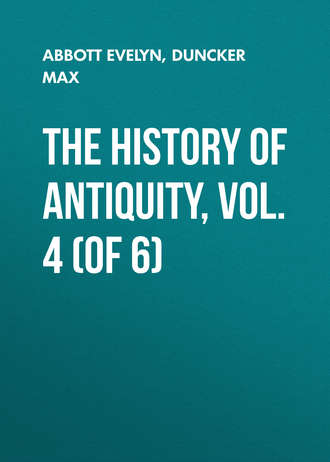 полная версия
полная версияThe History of Antiquity, Vol. 4 (of 6)
Though the doctrine of Buddha had received a firm basis immediately after the death of the master by the collection of his sayings, and the rules of ethics and discipline had been gathered together at greater length and in an authentic form at the synod of Vaiçali in 433 B.C., different tendencies and views inevitably arose among the believers as time went on. Some kept strictly to the sayings of the master, the principles of the synod; others commented on the traditions, and deduced consequences from the principles given. The speculative basis of the doctrine gave sufficient occasion to further research and meditation, and hence to the formation of different schools, which as they rose became rivals. The school of the Sautrantikas acknowledged only the authority of the sutras, the sayings of the master collected at the first synod, and abandoned any independent speculation. The school of the Vaibhashikas, i. e. the school of dilemma, drew speculative consequences from tradition, and ascribed canonical value to philosophical treatises (abhidarma), which were thought to come from the immediate disciples of Buddha, more especially from his son Rahula and from Çariputra. To these were added serious disputes on the discipline. The Bhikshus of Vaiçali who had been excluded from the community of the faithful by the second synod, are said to have adhered to their explanation of the discipline, and to have supported it by corresponding principles. This teaching of theirs, and the more lax observance of duties, they naturally explained to be the true doctrine of Buddha, and found adherents. At any rate we may easily see, that in the first half of the third century two hostile parties stood opposed in the Buddhist Church, the orthodox party, the party of the Sthaviras, and their opponents, who were denoted by the name Maha-Sanghikas, i. e. adherents to the great assembly. The more lax discipline which they preached, the more convenient mode of life which they permitted, are said to have brought numerous followers to this party. Brahmans are said to have taken the yellow robe without seeking for consecration, to have settled themselves in the monasteries, and filled everything with confusion and heresy.793 It is, no doubt, credible that when Açoka had openly gone over to the doctrine of Buddha, when he caused it to be preached with the authority of the state, and gave valuable gifts to the clergy, Brahmans would enter the viharas for other than spiritual reasons. We may further concede to tradition that it was Maudgaliputra, the head of the Açokarama, the monastery founded by Açoka at Palibothra, who caused a new synod to be assembled in order to establish the discipline and put an end to disputes. That such a synod did meet in the year 247 B.C. is proved by a letter which Açoka sent to this meeting in the seventeenth year of his reign at Palibothra; it has been preserved for us in the inscription of Bhabra (p. 525). "King Priyadarçin" – so the letter runs – "greets the assembly of Magadha, and wishes it light labour and prosperity. It is well known how great is my faith and reverence for Buddha, for the law and the community (sangha). All that the blessed Buddha has said, and this alone, is well said. It is for you, my masters, to say what authority there is for this; then will the good law be more lasting. The objects which the law comprises are the limits prescribed by the discipline, the supernatural qualities of the Aryas, the dangers of the future (i. e. of regenerations in their various stages), the sayings of Buddha, and the sutras of Buddha, the investigation of Çariputra and the instructions of Rahula with refutation of false doctrine: this is what the blessed Buddha taught. These subjects comprised by the law it is my wish that the initiated men and women hear, and ponder continually, and also the faithful of both sexes. This is the fame on which I lay the greatest weight. Hence I have caused this letter to be written to you which is my will and my declaration."794
Tradition tells us that at this synod the question was put to every Bhikshu: "What is the doctrine of Buddha?" and all who did not answer it satisfactorily or answered it in a sectarian sense, to the number of 60,000, were expelled from the community of the faithful. Then Maudgaliputra selected a thousand out of the number of the orthodox Bhikshus, men distinguished by virtue and true knowledge of the holy scriptures, that he might with them re-establish the purity of the sutras and the Vinaya, i. e. the rules of discipline. We cannot doubt that the synod at the Açokarama had revised the collection of sayings and rules of discipline established by the first two councils in order to excise interpolations and cut off false requirements; but this revision did not exclude extensions and additions which had been made in order to fill up in something more than a negative manner the ground occupied by the errors and heresies that had crept in. By this council, no doubt, the speculative part of the doctrine of Buddha received its first canonical basis. This may be inferred both from the mention of the investigation of Çariputra and the instructions of Rahula in the letter of Açoka to the assembly, and from the statement that the president of this council, Maudgaliputra, had founded a new school in order to unite the doctrines of the Sthaviras and the Mahasanghikas.795 What we possess of the canonical writings of the Buddhists does not go back in form or condition beyond this synod; yet it has been already remarked that in the sutras we can distinguish the older nucleus from the additions made to it, and retained or first added in the redaction of the third council. The assembly is said by the Singhalese to have occupied nine months in this new settlement of the canonical writings of the 'triple basket' (sutras, vinaya, abhidarma).
Açoka was in earnest with the doctrine of Buddha. "The man of loving spirit, beloved of the gods," we are told in the inscriptions at Girnar, "causes the observance of the law to increase, and the king's grandson, great-grandson, and great-great-grandson will cause the law to increase, and continuing stedfast down to the end of the Kalpa in law and virtue will observe the law."796 "In past days the transaction of business and the announcement of it did not take place at all times. Therefore I did as follows. At any hour, even when recreating myself with my wives in their chamber, or with my children, when conversing, riding, or in the garden, Pratidevakas (men who announce) were appointed with orders to announce to me the affairs of the people, and at all times I pay attention to their affairs."797 "I find no satisfaction in the effort to accomplish business; the salvation of the world is the thing most worth doing. The cause of this is the effort to accomplish business. There is no higher duty than the salvation of the whole world. My whole care is directed to the discharge of my debt to all creatures, that I may make them happy on earth, and that hereafter they may gain heaven. For this object I have caused this inscription of the law to be written. May they continue long, and may my grandson and great-grandson also strive after the salvation of the whole world. This it is difficult to do without the most resolute effort."798 In other inscriptions Açoka declares it to be his glory that he has administered justice properly, and inflicted punishment with gentleness; as we have seen, the book of the law required that it should be administered with severity. The growth of the law, king Açoka says, is brought about by submission to it, and the removal of burdens. "My Rajakas (overseers) are placed over many hundreds of thousands of my people, and their corrections and punishments are inflicted without pain. More especially I would have the Rajakas transact business in the neighbourhood of the Açvatthas (fig-trees), and bring happiness and prosperity to the people. I would have them be friendly, ascertain misfortune and prosperity, and speak to the people, as the law directs, saying: Receive with favour the law that has been given and established. In such a way are my Rajakas established for the good of the people, that they may transact their business in the neighbourhood of the Açvatthas quietly and without disinclination; for this reason painless corrections and punishments are prescribed for them."799 Açoka further informs us that in the war against the Kalingas he neither carried away the prisoners nor put them to death. For many offences he had abolished capital punishment. In the thirty-first year of his reign he appears to have abolished it altogether. The criminals condemned to death, he tells us in an inscription, must to the day of their death give the gifts that relate to a future life, and fast.800 According to the teaching of Buddha no animal is to be put to death. In earlier times, we are told in Buddha's inscriptions, for many centuries the killing of living things and the injuring of creatures had increased, as well as contempt for relations, and disregard for Brahmans and Çramanas; at one time even in his, Priyadarçin's, kitchen a hundred thousand animals were daily slaughtered for food. Now this was abolished. He absolutely forbade the slaying of certain animals, and everywhere introduced the two cures for sick men and animals, caused shelters to be erected for men and animals, fig-trees and groves of mangoes to be planted, wells to be dug on the highways, and resting-places for the night to be built.801 Himself anxious to follow the law of Buddha, he wished it also to be spread abroad and practised in his kingdom among his subjects. We have already mentioned the assemblies held at his command every fifth year, at which the chief rules of morals were taught to the people. In addition he nominated Dharmamahamatras, i. e. masters of the law, for the cities of his kingdom, the lands of the Vratyas (p. 388), and the territories dependent on him, whose duty it was to forward the reception and observance of the law. According to the inscriptions there were magistrates of this kind even at the court, to "divide gifts to the sons and other princes for the purpose of the observance of the law," and these magistrates had to perform the same duties in the chambers of the queens.802
What the tradition of the Buddhists tells us of the inexhaustible liberality of Açoka is exaggerated beyond all measure. The strangest statement of all, that he presented his kingdom to the Bhikshus, seems to find some sort of confirmation in the assertion of the Chinese pilgrim Fa-Hian, who was on the Ganges towards the year 400 A.D. He tells us that he had seen a pillar at Palibothra on which the inscription related that Açoka had presented all India, his wives and his servants, thrice to the Bhikshus, and had only retained his treasures, in order to purchase again these gifts. If this was really stated in the inscription, the matter can only have had a symbolical meaning; the king in this expressed figuratively his submission to the law of Buddha, and recognised it as his duty to allow the initiated, the representatives and preachers of this law, to suffer no want. Açoka's extant inscriptions prove that he not only exhorted his subjects to give (p. 530), but made presents to the Sthaviras, and commanded his masters of the law to divide gifts.803 How eagerly he strove to realise Buddha's precept to be helpful to every one, is proved by a sentence in the inscriptions of Dhauli in which the king says: "Every good man is my descendant."804
However foolish may be the tradition that Açoka built 84,000 stupas and as many viharas, it is true that he did erect numerous buildings which were mainly intended to glorify the Enlightened. Mention has already been made of the Açokarama at Palibothra, and tradition is not wrong in saying that the king honoured the places at which Buddha stayed by the erection of monuments. Of his buildings at Gaya we have, it is true, only the remains of pillars and other ruins.805 Some miles to the north of Gaya, on the bank of the Phalgu, in the rocks of the heights now called Barabar and Nagarjuni, are artificial grottoes. They are hewn in the granite, simple in plan and moderate in dimensions, but of very careful execution. The inscription on one tells us that it was consecrated by Açoka in the twelfth year of his reign, and on the other that Açoka caused it to be excavated in the nineteenth year of his reign.806 At Kuçinagara, on the place where the Enlightened slept never to wake again, the Chinese traveller Hiuan-Thsang found a pillar of Açoka's with inscriptions.807 The number of the monasteries or viharas in the territory of Magadha was so great that the old name of the country was changed for a name derived from them; it was called the land of monasteries: Vihara (Behar). The inscriptions already mentioned at Bhuvaneçvara refer to a stupa which Açoka built at Tosali in Orissa. According to the account of Hiuan-Thsang stupas of Açoka existed at his time in the Deccan among the Andhras and Cholas, the Kanchis and Konkanas; in Nagara he saw a stupa, and in Udyana a vihara of Açoka.808 The inscriptions of Açoka at Girinagara show that he erected a large bridge there and other buildings. Hence there is no reason to doubt the construction of considerable buildings in Cashmere, ascribed to him by the tradition of the land. On the northern slope of the Vindhyas, to the east of Ujjayini, at Sanchi, in the neighbourhood of the ancient Bidiça (now Bhilsa), there are nearly thirty stupas of very various sizes, standing in five groups. The longest of them rises on a substructure of more than one hundred feet in diameter to an elevation of sixty feet. The simplicity and unadorned dignity of the building mark this, the largest of the stupas, as also the oldest, and we may the more certainly regard it as a work of Açoka because relics are found in the neighbouring stupas which the inscriptions state to be those of Çariputra and Maudgalyayana, the eminent disciples of Buddha; others again which are said to be the relics of Gotriputra the teacher of Maudgaliputra, who presided over the third synod.809 The wall surrounding the great stupa presents an entrance through four noble portals of slender pilasters, united by cross-beams of singular workmanship. On the eastern gate there is found an inscription from the second century A.D. It is therefore possible that the outer wall dates from that time, though the inscription merely speaks of the presentation of a vihara situated there.810
However great Açoka's zeal for Buddha's doctrine might be, however numerous and splendid the buildings erected in honour of the Enlightened, he allowed complete toleration to prevail, partly from obedience to the gentleness which pervades Buddha's doctrine, but not less from motives of political sagacity. There was no oppression, no persecution of the Brahmans or their religion. It can hardly be called a proof of this feeling and attitude, that a ruined temple of Indra was restored at his command, for we have seen that Buddhism adopted the ancient gods of the Brahmans as subordinate spirits, yet as beings of a higher order, into its system. But in a part of his edicts Açoka mentions the Brahmans even before the Çramanas (in others the Çramanas have the first place); like the Çramanas the Brahmans are to be honoured and to receive presents. The inscription of Delhi declares that even those who are of another religion than the Brahmans and Buddhists are to live undisturbed; that all possessed sacred books and saving revelations. In one of the inscriptions at Girnar we are told: "Priyadarçin, the king beloved by the gods, honours all religions, as well as the mendicants and householders, by alms and other tokens of respect. Every one should honour his own religion, without reviling that religion of others. Only reverence makes pious. May the professors of every religion be rich in wisdom and happy through virtue."811
With all this toleration and gentleness there is no doubt that the reign of Açoka did the greatest service in promoting the spread of Buddhism through his wide kingdom. Whether and to what extent political motives could and did operate on his conversion we cannot even guess. In any case Buddha's doctrine released the ruler of the mighty kingdom from a very burdensome ceremonial; it put an end to the contrast in which the free life of the Indus stood to the restricted life of the Ganges; it counteracted the pride with which the Brahmans looked down on the not unimportant tribes on the Indus, placed the Arians on the Indus with equal rights at the side of the twice-born of Aryavarta, allowed the king to deal equally with all Aryas, all castes, and even with the non-Arian tribes of his kingdom; and not only permitted but commanded him to interest himself specially in the oppressed classes. The care, which his grandfather had already bestowed on husbandmen, Açoka could exercise over a wider territory and with greater earnestness; and that he did this, as well as how he did it, has been shown by his inscriptions (p. 535).
Tradition tells us that after the council of Palibothra, the Sthavira Madhyantika was sent into Cashmere and the land of the Gandharas to convert them, and the Buddhists could boast that the inhabitants of these districts received the law which Madhyantika preached to them; "that the Gandharas and Kaçmiras henceforth shone in yellow garments (the colour of the Bhikshus), and remained true to the three branches of the law."812 As a fact Cashmere became and remained a prominent seat of Buddhism. At the same time, according to tradition, Madhyama and Kaçyapa were sent to convert the Himalayas. In one of the smaller stupas at Sanchi chests of relics were found, the inscriptions on which describe one as containing the remains "of the excellent man of the race of Kaçyapa, the teacher of the whole of Haimavata;" the other as containing the remains of Madhyama.813 The conversion of the island of Ceylon at the time of Açoka, which was supported and advanced by Açoka's power and his relation to the king of the island, Devanampriya-Tishya, the successor of Vijaya, Panduvançadeva, and Pandukabhaya – who reigned from 245 B.C.814 to 205 B.C. – is a fact. Like Cashmere in the north, Ceylon became in the south a centre of the Buddhist faith, the mother-church of lower India and the lands of the East. It has been shown in detail above how the worship of relics arose among the Buddhists. Açoka's stupas exhibit it in the fullest bloom, and this form of worship is prominent in the tradition of the conversion of Ceylon. Beside the branch of the sacred tree of Buddha, which took root in the Mahamegha-garden at Anuradhapura, Ceylon boasts since that time the possession of the alms-jar of Buddha and his right shoulder-bone, to which his water-jug was added, and five hundred years later his left eye-tooth. This had previously been among the Kalingas, then in Palibothra, whence it was taken back to the Kalingas, from whence it was carried to Ceylon, after escaping the attempts made by the Brahman king of Magadha to destroy it. Saved at a later time from the arms of the Portuguese, it is preserved at the present day as the most sacred relic of the Buddhist church, and carried yearly in solemn procession.815
Buddhism had removed the privilege of birth. As it summoned the men of all castes equally to liberation, so it did not confine its gospel to the nation of the Aryas. When it had broken through the limits of caste it broke for the first time in history through the limits of nationality. All men, of whatever order, language, and nation, are in equal distress and misery; they are brothers, and intended to assist each other as such. To all, therefore, must be preached the message of renunciation and pity, of liberation from pain and regeneration. The tradition of the Buddhists has already told us that after the third synod messengers of the new religion were sent into the western land to the Yavanas, and into the gold land; and Açoka's inscriptions showed us that he had entered into connections not only with his neighbour, Antiochus Theos, but also with the kings of Macedonia and Epirus, of Egypt and Cyrene, concerning the good law. It is not likely that Buddhism was preached in the West beyond the eastern half of Iran and Bactria; but it found adherents there. Tradition tells us that a century after the council in the Açokarama at Palibothra belief in the Enlightened flourished in "Alassadda,"816 by which is obviously meant one of the three Alexandrias founded by Alexander in the East, apparently the Alexandria on the southern slope of the Hindu Kush nearest to Cashmere. When in the seventh century of our era the Chinese Hiuan-Thsang climbed the heights of the Hindu Kush on his pilgrimage to Cabul and India, he found the inhabitants of the city of Bamyan high up in the mountains zealously devoted to the religion of the Enlightened; he found ten viharas and a large stone image of Buddha in the city, covered with gold and other ornaments.817 On an isolated mountain wall in the midst of the mountain valley of Bamyan we find in a deep niche excavated in the wall a statue, now mutilated, 120 feet in height, and at a distance of two hundred paces, a second somewhat smaller statue of the same kind. In the broad lips and drooping ears of these statues our travellers seem to find portraits of Buddha. If this religion penetrated west of Cabul, in the Hindu Kush and to Bactria, it also extended from Cashmere to Nepal and Tibet, and from Ceylon struck root in lower India.
CHAPTER X.
RETROSPECT
The Arians in India at an early time developed important spheres of human nature into peculiar forms. In that tribal life, by no means feeble of its kind, which they lived in the land of the Panjab, they worshipped the spirits of fire, of light, of water; with deep religious feeling they invoked these helpers, protectors, and judges, with earnestness, zeal, and lively imagination. The movements of the emigration and conquest of the Ganges, the acquisition of extensive regions, led them forward on new paths. The emigrant tribes grew into nations; greater monarchies grew up in the conquered territories. The achievements of the forefathers were sung in heroic minstrelsy before the princes and their companions, the wealthy warriors, the priests, and the minstrels separated themselves from the peasants. The contrast between the new masters of the valley of the Ganges and the ancient population assisted in intensifying the distinction of orders among the Arians. The fear of the spirits of night and drought, the conception of the struggle of good and evil spirits, gave way before the abundance and fertility of these new possessions. In the land of the Ganges the sensuous perception of nature passed into fantastic ideas; the climate inflamed the susceptible senses of the nation, while at the same time it checked bodily activity and invited to contemplativeness. In opposition to the multitude of the ancient divine forms and the gorgeous variety of the new impressions of nature, rose the impulse to find the unity of the divine essence, the need of combination. Abstraction reacted on imagination, the spirit on the senses. The spirit in prayer, the holy spirit, and the world-soul, that mighty breath which the Brahmans seemed to find behind the changing phenomena of nature, were amalgamated by the priesthood, and elevated to be the highest deity: Indra, Varuna, Mitra must give way to Brahman as the nobles gave way to the priests. Together with the new deity, who was at the same time the order of the world, the Brahmans won for themselves the first position in the state.
The theory of the emanation of the world from Brahman established for ever the arrangement of the castes by the different participation of the various orders in Brahman – an arrangement which otherwise, being the result of natural changes, would in turn have been removed in the course of development. The law and the state were arranged on the plan of the divine order of the world which had assigned to every being his duties. With the emanation of beings from Brahman came the demand for their return thither, and the doctrine of regenerations, which were to cleanse the creatures rendered impure by their nature and their sins till they attained the purity of the world-soul. As Brahman was essentially conceived as not-matter, not-nature, a severance of nature and spirit, a contrast of the natural and the intellectual man was set up, which subsequently became the turning-point in the religious and moral development of the Indians. Ethics passed into asceticism, the courage of battle into the heroism of penance. But man could not rest content with the avoidance of sensuality or the mortification of the flesh. It was not enough to torment and crush the body, the Ego, the consciousness, must pass into Brahman. But, inasmuch as Brahman was all things and again nothing definite, it possessed no quality to be apprehended by thought; and along with the annihilation of individual being absorption in this impersonal deity required the surrender of the consciousness and perception of self, of the Ego in order to obtain a passage into this substance. Thus the crushing of the body by a pitiless asceticism, the destruction of the soul by meditation without any object, became the highest command, the ethical ideal of the Indians; the devotion natural to their disposition became a self-annihilating absorption into a soul-less world-soul. The energy of the Indians began to consume itself in this contest; it was applied to the conquest of the appetites, the crushing of the body, the annihilation of the soul. Under the most smiling sky, in the midst of a luxuriant vegetation, was enthroned a melancholy, gloomy, monastic view of the absolute corruption of the flesh, the misery of life on earth.


